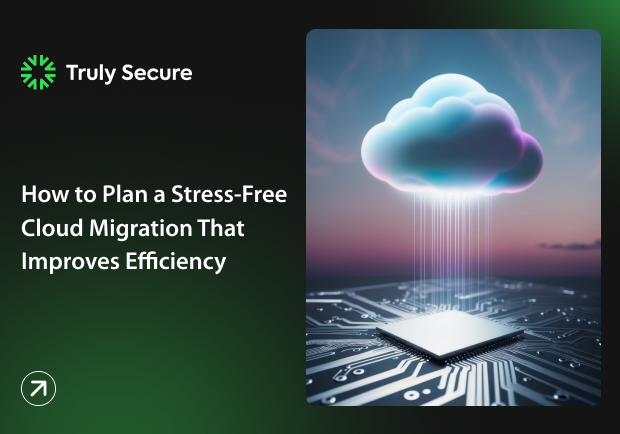Every company today talks about Cloud Migration, and for good reason. Businesses no longer want to be stuck with bulky servers, constant maintenance, and unpredictable IT costs. The cloud has become the smarter way to run operations,scalable, flexible, and cost-efficient. But while moving to the cloud sounds simple, many companies face hurdles like downtime, data security concerns, or even cost overruns if they don’t prepare properly.
That’s where having a clear migration strategy makes all the difference. When done right, a stress-free migration can modernise your systems, improve team productivity, and save money in the long run. The goal isn’t just to “shift data,” but to create a migration plan that improves efficiency and keeps your business running smoothly.
What Exactly Is Cloud Migration?
Think of cloud migration like relocating your office to a better building. You’re moving from old, crowded rooms to a modern space with better lighting, more security, and advanced facilities. But instead of furniture and files, you’re moving applications, databases, and IT infrastructure into the cloud.
The process may sound technical, but at its core, it’s about transferring data and workloads safely while ensuring that your systems perform better than before. That’s why businesses rely on a step-by-step migration plan instead of rushing in blindly.
Why Cloud Migration Is Worth It
When businesses follow the right cloud migration steps, they quickly notice powerful benefits:
- Reduced downtime migration: Minimal disruption to daily operations.
- Cloud cost optimisation: Pay only for the resources you use.
- Enhanced protection with a strong cloud security migration approach.
- Faster access and performance, especially for global teams.
- IT infrastructure modernisation Open the door to automation, AI, and analytics.
A key driver of digital transformation cloud projects, making companies future-ready.
Building a Strong Cloud Migration Strategy
Without planning, migration becomes messy. A reliable migration strategy ensures that your company moves step by step, with minimal risk. Here’s what a strong plan should cover:
- Set clear goals: Do you want cost savings, faster operations, or security improvements?
- Evaluate your current setup: Not all applications need to move at once.
- Pick the right approach: Sometimes a hybrid migration is smarter than moving everything.
- Choose a provider: AWS, Azure, or Google Cloud? Each has unique tools.
- Prepare your team: A smooth migration depends on skilled people as much as on technology.
A Stress-Free Cloud Migration: Step-by-Step
Assess Your Current Systems
Start with a migration checklist. Identify which applications are critical, which can be moved easily, and which may need rebuilding
Select the Right Provider
- AWS migration guide: Best for scalability and global reach.
- Azure migration plan: Perfect for companies using Microsoft products.
- Google Cloud migration: Strong for analytics and AI-driven operations.
Pick Migration Model
- Rehost (Lift & Shift): Quick move without changes.
- Replatform: Small improvements while moving.
- Refactor: Redesign apps to unlock full cloud potential.
- Hybrid cloud migration: Balance between cloud and on-premises.
Secure the Move
Cloud security migration is essential. Encrypt your data, define access controls, and meet compliance requirements.
Move in Phases
Start small. Move low-risk apps first, learn from the process, then shift bigger workloads. This phased approach ensures reduced downtime migration.
Optimise After Migration
Once moved, use migration tools to track performance and apply cloud cost optimisation strategies to cut unnecessary expenses.
Cloud Migration Best Practices
Here are the golden rules for a stress-free migration:
- Always create a detailed migration plan before starting.
- Use sandbox testing to avoid surprises.
- Move business-critical apps with extra care.
- Rely on automation and migration tools for repetitive tasks.
- Train your staff so they’re comfortable with new systems.
- Track improvements in uptime, performance, and costs to measure success.
Cloud Migration Case Study Example
A mid-sized e-commerce brand struggled with frequent downtime and slow systems. They followed a structured migration strategy, starting with non-critical apps and then moving their customer-facing website to a hybrid migration setup.
Results:
- Reduced downtime migration by 65%
- Achieved strong cloud cost optimisation by scaling resources only during peak sales seasons
- Modernised systems for smoother operations
- This migration case study shows that the right approach delivers not just efficiency but real business growth.
Tools That Support Cloud Migration
Some popular migration tools include:
- AWS Migration Hub for tracking progress.
- Azure Migrate for assessments.
- Google Cloud Migrate for lift-and-shift moves.
- Third-party solutions like CloudEndure and Carbonite.
These tools simplify data migration to the cloud and help maintain visibility throughout the process.
Cloud Migration as Part of Digital Transformation
Moving to the cloud is often the first step in digital transformation cloud projects. Once migrated, companies can adopt automation, predictive analytics, and global collaboration tools. A successful migration strategy builds the foundation for future innovations and keeps your business competitive.
Common Challenges in Cloud Migration
Even with a strong migration strategy, businesses often face unexpected roadblocks. Knowing them in advance helps you prepare:
Data Security Concerns
One of the biggest fears is whether sensitive data will remain secure during data migration to the cloud. The solution is to adopt a strict cloud security migration plan, encrypting files, managing access, and regularly auditing compliance.
Unexpected Costs
Many companies underestimate costs, thinking the cloud is always cheaper. Without proper planning, bills can pile up. The fix? Continuous cloud cost optimisation using built-in dashboards and alerts.
Downtime Risks
Even a few hours of downtime can impact revenue. That’s why following reduced downtime migration practices,such as phased migration and testing,is crucial.
Compatibility Issues
Some legacy systems don’t move smoothly. A hybrid cloud migration approach often works best, keeping older systems on-premises while modern apps shift to the cloud.
Lack of Skilled Teams
Tools are only as good as the people using them. Companies must train staff or work with migration services providers who have hands-on experience.
Advanced Cloud Migration Steps for Smooth Execution
Once you’ve covered the basics, here are some advanced migration best practices to ensure success:
- Pilot Testing: Before moving critical apps, run a trial migration with less important systems. This helps refine your migration checklist.
- Automated Monitoring: Use migration tools like CloudEndure or Azure Monitor to automatically detect errors during the move.
- Post-Migration Audits: Migration doesn’t end after shifting data. Auditing ensures that apps are performing as expected and security controls are intact.
- User Training Sessions: Teach employees how to work with the new systems. A smooth human transition is just as important as a technical one.
These steps transform a technical process into a stress-free migration experience.
Cloud Migration Benefits Beyond Efficiency
While most companies move to the cloud for cost savings and speed, the long-term migration benefits are much bigger:
- Scalability Without Limits: Businesses can expand into new markets without worrying about IT capacity.
- Global Collaboration: Teams across continents can work on the same systems without lag.
- Disaster Recovery: In case of data loss or technical failures, the cloud offers instant recovery options.
- Innovation Boost: Once in the cloud, companies can experiment with AI, big data, and automation tools,something not possible with outdated on-premise servers.
This is why many companies see migration as the foundation of full digital transformation cloud projects.
Choosing Between AWS, Azure, and Google Cloud
A big part of the migration plan is selecting the right provider:
- AWS Migration Guide: Known for flexibility, a huge global network, and industry-leading reliability.
- Azure Migration Plan: Ideal for businesses already using Microsoft tools like Office 365 and Dynamics.
- Google Cloud Migration: Excellent for businesses relying on data analytics, AI, and machine learning.
The best choice often comes down to your business goals. Some companies even combine them through hybrid cloud migration to get the best of all worlds.
Why Cloud Migration Is the Future of IT Infrastructure Modernisation
The old days of maintaining huge server rooms are gone. Companies want systems that are agile, cost-efficient, and future-proof. That’s why IT infrastructure modernisation is closely tied to migration.
- Migrating isn’t just about shifting what you already have; it’s about upgrading. For example:
- Retailers can integrate real-time analytics to forecast demand.
- Healthcare providers can store patient data securely with compliance checks.
- Startups can scale rapidly without upfront hardware investments.
Every industry benefits differently, but the common factor is clear: Migration strategy is now a business growth strategy.
A Realistic Cloud Migration Checklist
Before you begin, here’s a practical migration checklist:
- Assess all applications and decide which ones to migrate.
- Select a provider (AWS, Azure, or Google Cloud).
- Choose the migration model (lift-and-shift, replatform, refactor, or hybrid).
- Build a cloud security migration framework.
- Run a pilot migration for testing.
- Execute in phases for reduced downtime migration.
- Train your team on new systems.
- Optimise costs and monitor performance post-migration.
This checklist helps keep the process clear and structured, reducing risks along the way.
Cloud Migration and Business Transformation
When you look at successful companies today, most have something in common: they embraced migration early. Beyond improving IT, they’ve achieved full digital transformation cloud goals,like faster innovation, global scalability, and improved customer experience.
A well-planned migration strategy isn’t just an IT decision; it’s a boardroom decision that drives efficiency, growth, and long-term success.
How Truly Secure Can Help
At Truly Secure , we know that every company’s journey to the cloud is unique. That’s why we create custom migration plans designed around your goals, whether you need AWS migration guide support, an Azure migration plan, or Google Cloud migration expertise.
Our team ensures stress-free migration with:
- A tailored migration strategy
- Strong focus on cloud security migration
- Practical steps for reduced downtime migration
- Ongoing cloud cost optimisation
With Truly Secure, your migration benefits go beyond efficiency; we make your IT transformation smooth, secure, and sustainable.
FAQs
Q1. What are the main steps of a cloud migration?
The process involves assessment, planning, choosing the provider, selecting the right model, securing data, phased migration, and optimisation after the move.
Q2. How do I ensure a stress-free migration?
Follow a phased cloud migration plan, use migration tools, and rely on migration best practices to keep the process smooth.
Q3. Is downtime always unavoidable?
With reduced downtime migration practices, most businesses experience little to no disruption.
Q4. Which cloud provider is better,AWS, Azure, or Google Cloud?
All three are reliable. AWS migration guide is best for global reach, Azure migration plan works best with Microsoft environments, and Google Cloud migration excels in AI and analytics.
Q5. How do I control costs after migration?
Apply cloud cost optimisation practices like scaling resources only when needed, monitoring usage, and automating billing alerts.



